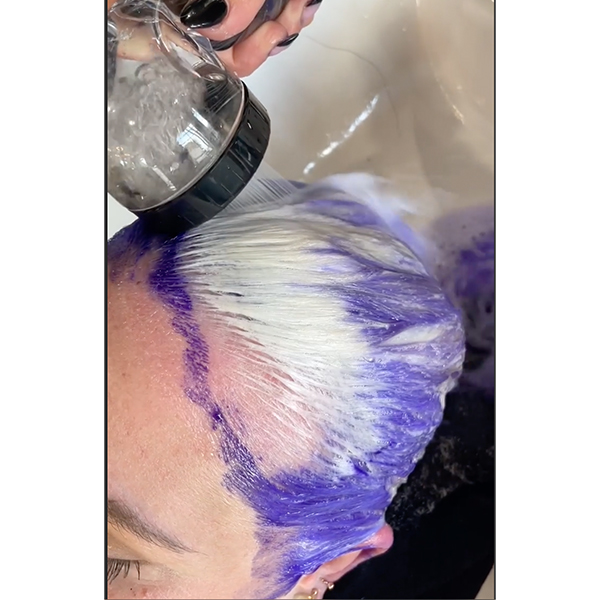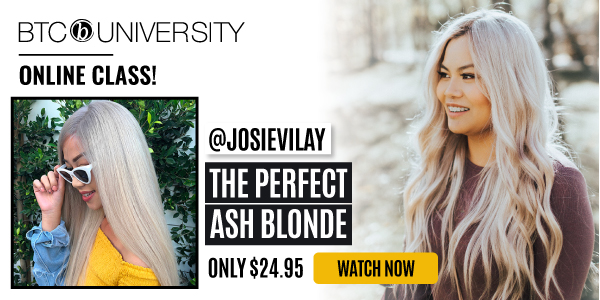What Would You Do: When Clients Say No To Toner
You know that achieving the perfect blonde is rarely done without toning the hair, but what if your clients don’t understand what that means? What if they are upset by the extra time in your chair and the extra charge on their card? Then what do you do?
We know this is a common issue at the salon because when one of our BTC members had the same question, we took to our social media fam for some answers—and you all had a lot to say! Get the full question and some fast tips for dealing with this situation below.
“I have several blonde clients that get mad/upset because I have to apply a toner. They think that I didn’t do a good job with the lightener and that’s the reason for the toner. I try explaining to them that if they want the cool/ashy tone, then I need to tone it. I don’t know what wording to use in my consultation to let them know why I need to apply a toner. I don’t know if they think I’m not doing a good job or if they are upset about the upcharge?”
Need some advice? DM us on Instagram and Facebook!
It’s simple—educate your clients
“Let them know that ‘lightener’ isn’t a color or a tone. It’s a raw cuticle that is open and if it’s not closed and the pH of the hair isn’t balanced, it can create damage and split ends over time. Then go into the chemistry behind it. Let them know lightener leaves the hair yellow, a little orange and sometimes white. And even if they love the color it is, it needs to be toned with clear to close the cuticle. Dry a small area and let them see how raw it looks and frizzy. We don’t tell them how to do their jobs. The proof is always in the pudding. If you can find an old mannequin head, do some highlights and on one side, tone using different shades so they can see how much better the hair looks toned verse the raw look on the other side.” – Kari Wilson
“My answer is simple. During your consultation, say this: ‘Your hair will most likely lift to [insert color here] stage, and will require a toner to achieve the desired results. Toners help close the cuticle and ensure you walk out happy. The entire service will cost [insert price here] and take approximately [time frame here]. Do you have any questions before you sign the color release form? Can I get you started with a cup of coffee while I’m mixing up your color?’ I also attach a sheet with product suggestions, touch-up guidelines and other important take-home information.” – Remi Meshel
“You need to order the underlying pigment swatch. I think Redken has one. But it just shows the underlying pigments at each level, on natural hair. So you can show them that’s what their hair will look like before toner. Problem solved!” – Ashley Morgan
“Tell them that the toner is the finishing touch that gives the blonde the shine and condition. I would also tell them that raw lightener will leave hair rough and more susceptible to damage from hot tools and the environment.” – Gina Salitore Lemond
“I’d tell them straight up how hair works. ‘When hair is lightened it goes through stages: red, orange, yellow and then pale yellow. With what you are looking for, I have to get you to pale yellow, and then tone. No other options because ashy hair doesn’t happen with lightener.’ Then show them the foil before you rinse to show you got them to the right level. Then from there they will let you do your job.” – Katharina Anne Loos
“My verbiage: ‘So, the science behind it is, lightener can only lift to a certain level, 1-10. 1 being the darkest, 10 being the lightest. But it can’t lift to a certain tone. That’s where toner (or gloss) comes into play. They come in many different options so that I can customize it to what you want your color to be. So wanting to be bright blonde, I would use a toner that will neutralize any unwanted warmth to give you the lightness you’re looking for!’ Talking science and the color wheel with them helps them understand that it’s not just a throw-bleach-on-the-scalp-and-your-hair-is-perfect type deal.” – Alexis Sartor
“Explain to the client that the lightener does the ‘lifting’ and ‘lifts’ the hair to a ‘raw blonde.’ You then need to tone this raw blonde to obtain the desired ‘color’ of blonde. Explain the blonde process as a two-step service. The first step is to lift, and the second step is to tone. Patience is key for the perfect blonde. They should be thankful that you are not rushing doing their hair and want to make a good job of it.” – jodi_hair_
Make it easy—include toner cost in the overall cost
“It’s because it’s charged as a separate service. Even when I did work in a salon that charged it as a separate service I would add it in the overall price. Say highlights were a $100 but toner was $20, in the consultation I would say the look you are going for is going to be $120. If they asked for a breakdown then that’s fine, but if it seems as if you were just adding something additional on at the end, it may look like an unnecessary upcharge. Customers don’t understand what’s necessary to achieve a certain look. Now that I own my own salon, toner is included with every lightening service for my own personal preference. No one is ever leaving the salon without a toner for any reason.” – @haircolorkilla
“If toner is part of the service to create and finalize your work, your prices should include it, not upcharge for it. A client will never have the choice to get a toner with me because it’s included in my price. Let’s be honest, toners are inexpensive. If I use a full two ounces, it’s worth $6 to have a beautiful walking advertisement.” – Heather Curry
“I tone 99 percent of my blondes. We use Redken Shades EQ at my salon and I explain to them that it not only tones, but it seals the cuticle and gives a nice shine. We don’t upcharge for our toners with highlights so maybe that helps with people not being upset, but it is very rare that I do highlights or any type of lightener on someone and not tone.” – Marguerite Hella Gilewicz
“Include it all as one price…clients don’t know anything about how color, lightener or toners work. You are the professional. Stand your ground with these know-it-all clients of yours…some hair can do a straight color, others need it to be lightened and toned” – Karen J. Conforzi
“I don’t believe in charging for glosses or toners, unless it’s for maintenance purposes in between appointments. Ultimately, you’re giving the option to be able to finish your work.” – @meganheathercolorist
Change the name—call it a gloss or a glaze (it sounds better!)
“I would maybe use the word gloss or tell them you want to keep their hair in the best possible healthy state, and to prevent it from over processing, you must use a toner to cancel out and tone to their desired color. The toner also adds tremendous shine and smooths the cuticle back into restoration!” – Kristin Lindauer Horgan
“I try to make it sound like it’s doing more than just toning. I call it a glaze. I explain to clients that it makes sure the tone is even, adds shine to the hair, seals the cuticle (which helps the shine and tone stay longer) and it will make their hair feel soft! It puts it in their mind that it’s good for their hair. Just make sure to know that your color line has those benefits, or consider switching to one that does.” – Jess Kimball
“I would use the term gloss and say it’s part of the blonding process to achieve the look they are wanting. Then explain its benefits—like the specific blonde they want, added shine, etc. Sometimes clients don’t understand the ‘whys’ to what we do. Educating is so helpful and they always appreciate it. I would also recommend a purple shampoo for them.” – Desiree Fi
“I never call it a toner, I usually say something along the lines of, ‘This color is beautiful! Once we are done processing I will be applying a color gloss. It helps even out the tones to give it exactly what you like! It also adds shine and reduces frizz!’ I never get questions!” – Lynda Shaw Chaves
“At my salon we call it a gloss, and it is explained that it is a step that we take with all blondes to condition the hair and give it a shiny finish. If they ask more questions we say that when applying lightener, you expose the hair’s natural undertones and the gloss makes the undertones look more natural. 😀 Never have too much of an issue with it that way.” – @haleywilliams0305
And if you still haven’t convinced them…make your point some other way 😂
“Let them go home with yellow hair one time…that ought to teach them! 😕 I used to explain, but then I got to the point with my blondes where I say, ‘This is my standard of work and what I do, if you dislike the cost you can attempt to find a stylist who will do what I do for less.’ They immediately understand. I had two of my blondes try someone else and both were in my chair within the week to ‘fix’ their hair. It cost them twice as much and lesson learned.” – Gigi Khaziran
“I refuse to not tone my blondes. I don’t care if they want a natural blonde, I’m still toning it. Raw highlights always end up yellowing no matter what. I tell every blonde I do that they’re getting a tone so it doesn’t end up yellow or brassy after a few weeks. They are paying a lot for their blonde and they need to trust we know what we’re doing.” – LeeAnna George
“Don’t do the toner next time, charge the same, and I bet they’ll be asking for you to do it. I always include the toner in the price. It’s just part of the process. Let them see the difference it makes.” – Hollie Strzyzewski









